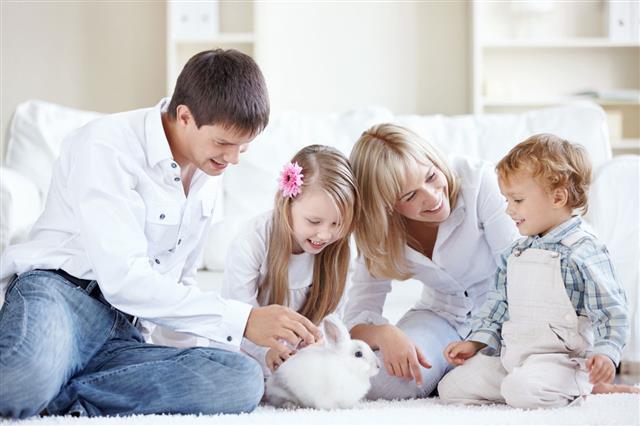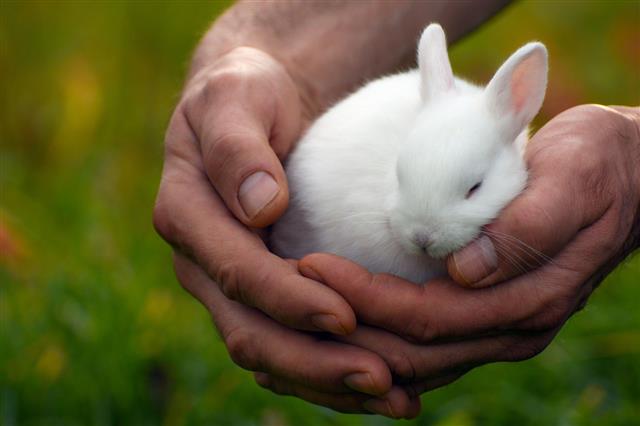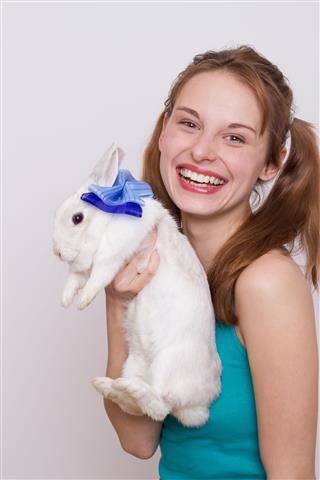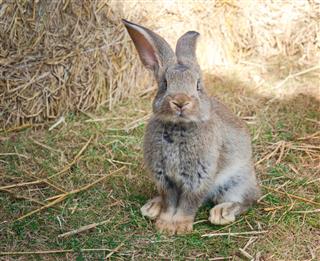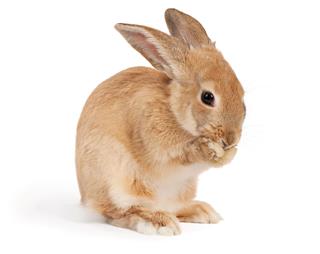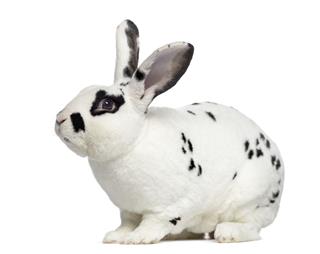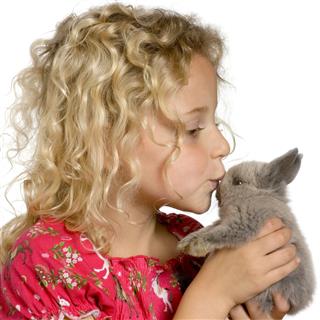
Pet rabbits, or rather, any pet requires great personal care and grooming. You can have a great time with your pet rabbit if you are aware of certain facts about what to feed it, how to handle it and proper healthcare. Educate yourself with the guidelines for complete care of your pet rabbit to ensure it is healthy and happy.
Did You Know?
The world’s biggest rabbit is Darius, a Continental Giant, from Worcester England who weighs an unprecedented 50 pounds, and is over 4 feet long!
Rabbits are easy-to-keep pets, all you have to do is feed them, put them in a big cage. Some exercises and an occasional cleaning of the cage, and that’s it!”. This statement is partly right and partly wrong. Right because maintaining a healthy pet rabbit is not at all difficult. Wrong because unless you are aware of all the facts about rabbit food, health care, the “dos and don’ts”, things could really go wrong. With pet rabbits, it is the minor facts that matter: what you feed them, the amount of exercise they get, even how you handle them.
Before Buying a Pet Rabbit
Ask yourself:
~ Do I already own a pet that could pose a threat to the rabbit? (dog, cat, etc.)
~ What will it cost me to take care of the rabbit? (Cage, food, the occasional veterinarian expense etc.)
~ Are all the supplies that will be required available? (Mostly food requirements)
~ And finally, do I have the time to take proper care of the rabbit?
After considering the above questions, now comes the step where you choose the right one. There are over 150 recognized rabbit coat colors and varieties, ranging from snow-white to gray and single color to stripes. The best solution is to visit your local pet store and see what choices are available.
Decide a cage for your rabbit. You should buy a cage that allows the rabbit to stand up, fully stretched on its hind legs without any obstruction. While choosing a cage for your rabbit ensure that there is extra space to accommodate a litter box, including space for the feed and water. The cage must be easy to clean and sturdy. A metal cage with a wire mesh floor is the most preferable choice.
Food is of utmost importance. The entire health and well-being of the rabbit will depend on this. As you read the part on feeding your rabbit, you will realize the importance of choosing the proper food for your rabbit. Pet rabbits usually live 7 to 8 years, but feeding your pet the proper diet should ensure it lives 10 to 12 years. Pet rabbits have been known to live up to 15 years given the proper care.
What are Rabbits Like?
Many are curious to know whether owning a rabbit is like owning a cat or a dog; you should know, that it is neither. Pet cats and dogs will take an immediate liking to you, and not be afraid. This will take much longer with a pet rabbit. Pet dogs/cats can be fed on a variety of foods – veggies, fish, chicken, etc. Pet rabbits have a very sensitive gastrointestinal tract.
Petting and Fondling Rabbits
Pet rabbits are very affectionate, but could get really aggressive and destructive at times. Don’t be under the misconception that it can petted and cuddled like a stuffed toy; the slightest mishandling of your rabbit could prove fatal. Thus handling a rabbit gently, is very important.
When you bring your new pet rabbit home, decide the location of the cage. Place it as close to the ground as possible where it will not obstruct the pet’s movement. The place should be well ventilated with a free flow of fresh air. Place a straw bed so that the rabbit feels comfortable. Remember, the cage is not a place to confine your pet, it is where the rabbit will retire for the night or whenever it is tired/hungry.
Problems due to Cage Confinement
Leave your pet rabbit’s cage open, as far as possible. Ensure that the surroundings are safe when it is outside the cage. If you confine your pet, it could suffer from poor muscle tone because of no exercise, inflammation of the feet due to sitting in one place constantly, lethargy, aggressiveness, and obesity due to lack of exercise.
Important Note Regarding Exercise and Confinement
A rabbit requires constant activity. Rabbits love jumping and running around. This helps keep their bodies in shape, their minds active and alert, and also helps in eliminating diseases. Lack of space and exercise will make your rabbit dull and unenthusiastic, and it will no longer be the happy, jumping-about rabbit that you thought it would.
Rabbits are herbivores; your pet’s primary diet should include grass, leaves, and hay (fresh and dry, of course). Occasionally, feed your rabbit fruits such as pineapple, pear, peach, papaya, and any of the sweet berries. Special treats could include edible flowers, such as roses and lilies.
The Digestion Process
Proper care should be taken about your pet rabbit’s diet so that it remains disease-free, active, and enjoys a long, healthy life. All rabbits eat grass. Part of this goes into the intestinal tract known as the cecum, where it is converted into small, soft pellets filled with nutrients, known as cecotropes. These are easily digested and contain fatty acids, vitamins and amino acids, which are all very important for the well-being of the rabbit.
Quality of Hay
If you feed your pet rabbit mostly with hay, ensure that it is dry and fresh and there is an adequate quantity in the rabbit’s cage. There are two types of hay – grass and legume; ensure that the hay is the grass variety. Meadow grass, which is naturally sun-dried, is the best. Find out where you can have easy access to such grass/hay. It will be required throughout the life of the rabbit.
Important Note
Constant chewing and munching of this hay will not really result in the rabbit spoiling its teeth. Also, remember that rabbit teeth grow constantly, eliminating the possibility of teeth destruction.
Say No to Commercial Rabbit Food
As far as possible stay away from commercially available rabbit food, as these are usually packed with starch and fat which will result in a rabbit to grow plump very fast. Many would think that this is beneficial, but it is just the opposite. Many nutrients present in natural food may not be present in commercial food. No doubt, your rabbit will look cute and chubby for some time, but sooner or later it will begin to suffer.
Not Plump, but Healthy
A plump fat rabbit may not necessarily mean a healthy rabbit. Healthy rabbits have a strong muscular tone with minimal fat. A proper diet and enough exercise will not only ensure that your rabbit is in the pink of health, but also reduce your veterinary bills.
Rabbits have very fragile backbones. To avoid injuries, pick it up carefully; put one hand below its hind legs for support, the other below its chest, then lift it. The entire weight of the rabbit must rest on your hands. Prevent small children from picking up the rabbit. They tend to get a bit excited and might cause it unintentional harm. If they insist on carrying it, train them in the technique of lifting the rabbit.
What Not to Do When Lifting the Rabbit
Never pick up your rabbit in such a way that its hind legs are left dangling. The rabbit might kick violently, possibly fracturing its backbone which can prove fatal. Make sure that this does not happen, because the only solution, if this happens, is to put the rabbit to ‘sleep’. Never lift the rabbit by its ears. It is very painful for the rabbit, just like it would pain if someone tried to lift you by the ears.
If you notice something different, it may be time to take your pet to the veterinarian. Anything that seems abnormal should not be ignored, as it may lead to further complications. This may include:
~ Sudden loss in appetite
~ Sudden weight loss
~ Suddenly wanting to be confined to the cage
~ Extremely aggressive behavior
~ Diarrhea
If you feed your rabbit properly and allow it to exercise enough, you may never need to call the veterinarian. But, do watch out for abnormal behavior in your pet, because unlike cats/dogs, rabbits don’t have a very strong immune system. Do not wait for the symptoms to subside when you see any, call the veterinarian immediately. Based on the symptoms, he will let you know the urgency.
Preparing a Litter Pan for Your Rabbit
To begin with, collect some hay and non-clumping rabbit litter and put it in a 4-inch high litter pan. Place some pebbles and hay from the rabbit cage into the litter pan. Now, place this in the familiar room where your rabbit plays. Place the rabbit in the litter box and prompt him to use the litter box.
Don’t Use Cat Litter Pans
Your rabbit litter pan is different from the regular cat litter, so make sure you don’t use the latter. Training a rabbit may sound difficult, but it is fairly easy. In fact this should be the first thing you teach your rabbit, it will eliminate the efforts of cleaning up.
When you place your pet in the litter pan, he may hop out suddenly; do not panic, litter training can take some time. Let him hop around for some time and then repeat the command. When he finally uses it, praise him and cuddle him a bit. But remember, do not give your rabbit a treat. Do this for a week and your rabbit should hop in the litter pan whenever he is let out of the cage.
Buy your pet rabbit from a reputed pet shop. Whenever possible, keep the cage open and try to place the cage where there is a good circulation of fresh air. Always keep the cage clean, with a sufficient stock of fresh food and water. Be very careful while lifting and handling your rabbit. Take your pet rabbit to the veterinarian as soon as you notice the slightest change in its behavior.
